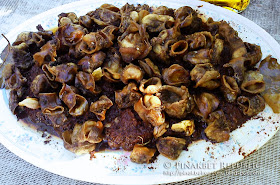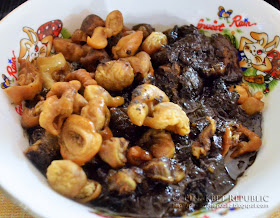 |
| Namaga a dinardaraan a naparabawan iti naparsik a silet. |
And dinardaraan, is prepared/cooked and served in a variety of ways. With Ilokanos, most prefer the dry one, the blood a kind of paste, with its meat and/or offals deep fried into crackling crunchy bits, like these two dinardaraan varieties in Tuguegarao City:
And this one from Ilocos Norte (Laoag City), served with the fried pork intestines/tripe put atop the cooked blood:
And then, later the fried intestine is mixed up with the blood:
Some Ilokanos prefer a slightly dry dinardaraan, with a little thick broth for the rice:
And this is a soupy dinardaraan, also preferred when one is fond of kaldo. The broth is great with sili ti sairo and suka ti basi for a hot dinardaraan soup:
When I cook dinardaraan, I have two options, dry and soupy, for I love my rice with blood soup:
How about you, how do you like your chocolate?
:::::









No comments:
Post a Comment